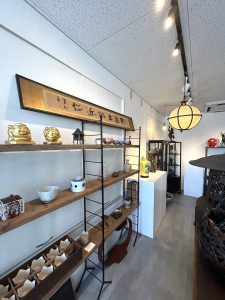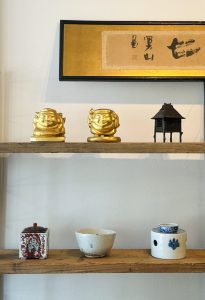やはり金色には特別感があるようです(愛知県名古屋市千種区姫池通 骨董買取 古美術風光舎)
2024.08.21
皆さまこんにちは。スタッフHでございます。
昨日の朝は窓を開けると避暑地にでも来たのかと錯覚するほど涼しかったのですが、今朝はいつもの名古屋の夏の暑さでございました。一瞬でも外気の涼しさに触れると、いつにもまして暑さが身に染みます。

さて今朝、通勤電車の中で‘五輪金メダルの劣化’云々の記事を目にしました。真偽のほどは分かりませんが、何人かの選手が東京五輪の金メダルと比較した写真などを投稿しているようです。個人的にはよく判別できませんでした。そもそもそれぞれの国でメダルの製造方法が異なっていているようです。
東京五輪のメダルは「勲章」の技法で作られ、パリ五輪のメダルは「硬貨」の製法で作られているそうで、違いは詳しく分かりませんがデザインから製造方法まで開催国に一任されているようですね。
投稿している選手は2大会連続で金メダルを獲得しているからこそ比較できる訳で、凄いことだなと主旨から外れた感想を持ってしまいました。
恐らくほとんどの選手にとって一生に一度の金メダルとなり、子孫代々受け継がれ、偉業を語り継がれていくと期待しているのではないでしょうか。いつまでも金色に輝き続けてほしいという願いは当然のように思えます。なかなか難しいのかもしれませんが…。
さて風光舎を見回してみますと、帝国技芸員の一人でもある平櫛田中作、金色に輝く恵比須様と大黒天様のブロンズ像(鋳物)がございます。金箔で仕上げられており存在感を放っているのですが、2等身のころんとしたお姿が愛らしく見る者を和ませてくれます。

平櫛田中といえば彩色を施した木彫が有名で、歌舞伎6代目尾上菊五郎が舞う姿を彫った「鏡獅子」は22年の歳月をかけて完成させ、高さ2メートルもある作品です。幾重にも重なった衣装の下で実際の骨格や筋肉がどうのようになっているのかを知るために尾上菊五郎のもとに通い、衣装なしでポーズとった姿を「鏡獅子試作裸像」として事前に作っています。衣装の中身の細部に至るまで掴もうとしていたようです。一転して店内にございます恵比須様と大黒様はかなりデフォルメされたお姿で芸術家の頭の中はどうなっているのだろうと不思議なところでございます。
金箔の話に戻りますが、日本の金箔は98%以上が金沢で作られているとのこと。2グラムの金を畳一畳分にまで伸ばすのだとか。日本で金箔がいつ頃作られたかは不明のようですが、金箔を施された古墳時時代のアクセサリーが見つかっているそうです。仏教伝来とともに中国から伝わった製箔技術が日本において独自の発展を遂げたと言われています。
金沢で初めて金箔が作られ始めた時期が定かではないそうですが、1593年、加賀藩の前田利家が豊臣秀吉より明の使節団の出迎え役を申し渡され、装飾のための槍などを飾るため利家が加賀、能登で金箔、銀箔の製造を命じたとされています。
黄金好きで知られる豊臣秀吉は調度品などに金箔を好んで使用し、諸大名も権力の象徴として瓦や内装に金箔を使っていたとされています。
徳川家康の時代になり経済強化のため「箔打ち禁止令」が出され、京都以外では金箔、銀箔の生産は厳しく禁じられることとなりました。しかし加賀藩では密かに続けられ、限られた材料で技術を研鑽し、輪島塗や山中塗、加賀蒔絵など今も私たちを魅了する伝統工芸の技法として受け継がれています。
ところでお菓子や飲み物に金箔が入っていることがありますね。とても華やかな雰囲気なのですが、食べても大丈夫なのかな?とかすかな引っ掛かりを感じながらいただいております。でんぷん質が含まれている食用金箔もあるようですが、フレーク状や非常に薄いシート状のものは純金箔だそうです。基本的には金は体内で吸収されず、かなり薄く伸ばしていることもあり食べても問題はないようです。また金箔は血行促進や抗酸化作用があるとされ化粧品にも使われており、金の顔パックシートもあるとか!ここぞという時に使ってみてはいかがでしょうか。
それでは、また次の機会に。
Hello everyone. This is Staff H.
Yesterday morning it was so cool that when I opened the window, I thought I was in a summer resort, but this morning it was the usual Nagoya summer heat. Whenever I feel the coolness of the outside air, even for a moment, the heat sinks in more than ever.
This morning, on the train to work, I saw an article about the “deterioration of Olympic gold medals. I am not sure if it is true or not, but it seems that some athletes have posted photos comparing their medals with the gold medals of the Tokyo Olympics. Personally, I could not distinguish them well. It seems that the medals are manufactured differently in each country.
The medals for the Tokyo Olympics are made using the “medal” technique, while the medals for the Paris Olympics are made using the “coin” method.
I don’t know the details of the difference, but it seems that the design and production methods are left up to the host country.
It is probably a once-in-a-lifetime gold medal for most of the athletes, and they expect that it will be passed down to their descendants and their achievements will be passed on to future generations. It seems natural to hope that they will continue to shine gold forever. It may be quite difficult….
Looking around the Fuhkosha, there are bronze statues of Ebisu-sama and Daikokuten-sama (cast metal), both shining in gold, by Hirakushi Denchu, one of the Imperial Artists in Charge. The gilded finish gives the statues a strong presence, and their two-length, rounded figures are charming and comforting to the viewer.
Hiragushi Denchu is famous for his colored wood carvings, and his “Kagami-jishi (mirror lion),” which depicts Kabuki actor Onoe Kikugoro VI dancing, took 22 years to complete and stands 2 meters high. In order to understand what the actual skeleton and muscles looked like under the layers of costume, the artist went to Onoe Kikugoro and created a “prototype naked figure of Kagami-jishi” in advance, showing him posed without costume. It seems that he was trying to grasp every detail of what was inside the costume. On the other hand, Ebisu-sama and Daikoku-sama in the store are quite deformed, which makes us wonder what is going on in the mind of an artist.
Returning to gold leaf, more than 98% of Japan’s gold leaf is made in Kanazawa, where 2 grams of gold can be stretched to the size of a tatami mat. It is unknown when gold leaf was first produced in Japan, but gilded accessories from the Kofun period have been found. It is said that the technique of gold leaf making, which was introduced from China along with the arrival of Buddhism, developed uniquely in Japan.
It is not known when gold leaf was first produced in Kanazawa, but it is said that in 1593, Maeda Toshiie of the Kaga Clan was asked by Toyotomi Hideyoshi to welcome a delegation from Ming Dynasty China, and Toshiie ordered the production of gold and silver leaf in Kaga and Noto to decorate lances and other objects for decoration.
Toyotomi Hideyoshi, who was known for his love of gold, favored the use of gold leaf for furnishings, and it is said that the feudal lords also used gold leaf for roof tiles and interior decorations as a symbol of their power.
During the reign of Tokugawa Ieyasu, the production of gold and silver leaf was strictly prohibited outside of Kyoto due to a “ban on foiling” issued to strengthen the economy. However, the Kaga Clan secretly continued to produce gold and silver leaf, and with the limited materials available, the technique was refined and passed on as a traditional craft technique that still fascinates us today, such as Wajima-nuri, Yamanaka-nuri, and Kaga maki-e (maki-e lacquerware).
By the way, you sometimes find gold leaf in sweets and drinks. It looks very glamorous, but is it safe to eat? I have a faint feeling of uneasiness when I eat them. There are edible gold leaves that contain starch, but those in flake or very thin sheet form are said to be pure gold leaf. Basically, gold is not absorbed by the body, and there seems to be no problem in eating it, partly because it is stretched very thin. Gold leaf is also used in cosmetics for its blood circulation promoting and antioxidant properties, and there are even gold face pack sheets! Why don’t you try using it when you have a special occasion?
See you next time.
*******************
ご実家の整理やお片付けなどをされている方のご相談などが多くございます。
お片付けなどくれぐれもご無理のないようになさってくださいませ。
風光舎では古美術品や骨董品の他にも絵画や宝石、趣味のお品など様々なジャンルのものを買受しております。
お片付けをされていて、こういうものでもいいのかしらと迷われているものでも、どうぞお気軽にご相談下さいませ。
また風光舎は、出張買取も強化しております。ご近所はもちろん、愛知県内、岐阜県、三重県その他の県へも出張いたします。
まずは、お電話お待ちしております。
愛知県名古屋市千種区姫池通
骨董 買取【古美術 風光舎 名古屋店】
TEL052(734)8444
10:00-18:00 OPEN
#出張買取#骨董#古美術#骨董品#絵画#版画#茶道具#刀剣#彫刻

